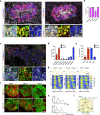Jag1-Notch cis-interaction determines cell fate segregation in pancreatic development
- PMID: 36681690
- PMCID: PMC9867774
- DOI: 10.1038/s41467-023-35963-w
Jag1-Notch cis-interaction determines cell fate segregation in pancreatic development
Abstract
The Notch ligands Jag1 and Dll1 guide differentiation of multipotent pancreatic progenitor cells (MPCs) into unipotent pro-acinar cells (PACs) and bipotent duct/endocrine progenitors (BPs). Ligand-mediated trans-activation of Notch receptors induces oscillating expression of the transcription factor Hes1, while ligand-receptor cis-interaction indirectly represses Hes1 activation. Despite Dll1 and Jag1 both displaying cis- and trans-interactions, the two mutants have different phenotypes for reasons not fully understood. Here, we present a mathematical model that recapitulates the spatiotemporal differentiation of MPCs into PACs and BPs. The model correctly captures cell fate changes in Notch pathway knockout mice and small molecule inhibitor studies, and a requirement for oscillatory Hes1 expression to maintain the multipotent state. Crucially, the model entails cell-autonomous attenuation of Notch signaling by Jag1-mediated cis-inhibition in MPC differentiation. The model sheds light on the underlying mechanisms, suggesting that cis-interaction is crucial for exiting the multipotent state, while trans-interaction is required for adopting the bipotent fate.
© 2023. The Author(s).
Conflict of interest statement
The authors declare no competing interests.
Figures






Similar articles
-
Jag1 Modulates an Oscillatory Dll1-Notch-Hes1 Signaling Module to Coordinate Growth and Fate of Pancreatic Progenitors.Dev Cell. 2020 Mar 23;52(6):731-747.e8. doi: 10.1016/j.devcel.2020.01.015. Epub 2020 Feb 13. Dev Cell. 2020. PMID: 32059775
-
Two Notch ligands, Dll1 and Jag1, are differently restricted in their range of action to control neurogenesis in the mammalian spinal cord.PLoS One. 2010 Nov 24;5(11):e15515. doi: 10.1371/journal.pone.0015515. PLoS One. 2010. PMID: 21124801 Free PMC article.
-
Notch ligand, JAG1, is evolutionarily conserved target of canonical WNT signaling pathway in progenitor cells.Int J Mol Med. 2006 Apr;17(4):681-5. Int J Mol Med. 2006. PMID: 16525728
-
An oscillatory network controlling self-renewal of skeletal muscle stem cells.Exp Cell Res. 2021 Dec 15;409(2):112933. doi: 10.1016/j.yexcr.2021.112933. Epub 2021 Nov 15. Exp Cell Res. 2021. PMID: 34793773 Review.
-
The oncogenic role of Jagged1/Notch signaling in cancer.Biomed Pharmacother. 2020 Sep;129:110416. doi: 10.1016/j.biopha.2020.110416. Epub 2020 Jun 25. Biomed Pharmacother. 2020. PMID: 32593969 Review.
Cited by
-
The salt-and-pepper pattern in mouse blastocysts is compatible with signaling beyond the nearest neighbors.iScience. 2023 Sep 30;26(11):108106. doi: 10.1016/j.isci.2023.108106. eCollection 2023 Nov 17. iScience. 2023. PMID: 37915595 Free PMC article.
-
Oscillatory control of embryonic development.Development. 2024 May 1;151(9):dev202191. doi: 10.1242/dev.202191. Epub 2024 May 10. Development. 2024. PMID: 38727565 Free PMC article. Review.
-
Cis inhibition of NOTCH1 through JAGGED1 sustains embryonic hematopoietic stem cell fate.Nat Commun. 2024 Feb 21;15(1):1604. doi: 10.1038/s41467-024-45716-y. Nat Commun. 2024. PMID: 38383534 Free PMC article.
-
Diversity in Notch ligand-receptor signaling interactions.Elife. 2025 Jan 3;12:RP91422. doi: 10.7554/eLife.91422. Elife. 2025. PMID: 39751380 Free PMC article.
-
Autologous transplantation of P63+ lung progenitor cells in patients with bronchiectasis: A randomized, single-blind, controlled trial.Cell Rep Med. 2024 Nov 19;5(11):101819. doi: 10.1016/j.xcrm.2024.101819. Cell Rep Med. 2024. PMID: 39566467 Free PMC article. Clinical Trial.
References
Publication types
MeSH terms
Substances
LinkOut - more resources
Full Text Sources
Molecular Biology Databases

